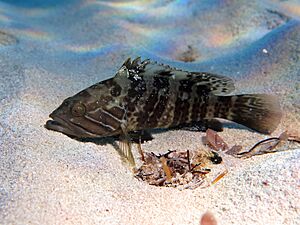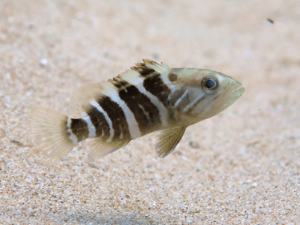White grouper facts for kids
Quick facts for kids White grouper |
|
|---|---|
 |
|
| Conservation status | |
| Scientific classification | |
| Synonyms | |
|
The white grouper (Epinephelus aeneus) is a type of ray-finned fish that lives in the ocean. It belongs to a group of fish called groupers. These fish are part of a larger family called Serranidae, which also includes sea basses. You can find the white grouper in the warmer parts of the eastern Atlantic Ocean and the southern Mediterranean Sea.
Contents
What Does the White Grouper Look Like?
The white grouper has a head that is longer than its body is deep. Its body is about 3 to 3.6 times deeper than its length. The top of its head, between its eyes, is curved. It has a special bone near its gills called the preopercle. This bone has 3 to 6 large, sharp points at its corner.
Its dorsal fin (the fin on its back) has 10 to 11 stiff spines and 14 to 16 soft rays. The anal fin (underneath its body) has 3 spines and 7 to 9 soft rays. Its tail fin, called the caudal fin, is rounded. The fish's body is covered in small scales. These scales are set into thick skin. It has more than 90 scales along its lateral line, which is a special line of sensors on its side.
The white grouper is usually a greenish-bronze color. Its fins are darker, often brownish-purple, with white or light edges. It has 3 or 4 pale blue or white lines on its gill cover. These lines can be hard to see in older, larger fish. Young white groupers have faint dark spots on their bodies. These spots form 5 unclear dark stripes. Young fish also have faint dark spots on their fins.
This fish can grow up to 120 centimetres (47 in) long. That's about 4 feet! However, they are more commonly around 60 centimetres (24 in) long, which is about 2 feet. The heaviest white grouper ever recorded weighed 25 kilograms (55 lb).
Where Do White Groupers Live?
White groupers live in the eastern Atlantic Ocean. You can find them from southern Portugal and Spain all the way down the west coast of Africa to Angola. They also live around islands in the Gulf of Guinea. Scientists are still checking if they live near the Canary Islands and Madeira.
They are also found in the southern and eastern parts of the Mediterranean Sea. Recently, they seem to be moving further north. They used to not be found north of 44°N in the Adriatic Sea. They were also thought to be missing from the central Mediterranean. But now, they have been seen near Corsica and Monaco, and in other northern Mediterranean areas.
Sometimes, these fish travel far from their usual homes. For example, a white grouper was once found in Cornwall, in southwestern England.
White Grouper's Home and Habits
White groupers like to live on rocky areas, or on muddy and sandy seabeds. Young white groupers, called juveniles, live in coastal lagoons and river mouths. Adult fish live in deeper waters, from about 20 metres (66 ft) to 200 metres (660 ft) deep.
This fish is a carnivore, meaning it eats other animals. Off the coast of West Africa, scientists found that white groupers mostly eat other fish (58% of their diet). They also eat mantis shrimp (21%), crabs (10%), and squid or octopuses (10%).
Some white groupers migrate, or move, with the seasons. This happens off the coasts of Senegal and Mauritania. Their movement is linked to ocean currents that bring cold, nutrient-rich water to the surface.
Reproduction and Life Cycle
White groupers are special because they are protogynous hermaphrodites. This means they are born female and later in life can change into males. Females become ready to have babies when they are about 50 to 60 centimetres (20 to 24 in) long. This usually happens when they are 5 to 7 years old. They change into males when they are 10 to 13 years old.
Off the coast of Tunisia, these fish lay their eggs, or spawn, in June and July. In Iskenderun Bay in Turkey, spawning starts in early June and continues until late August.
Naming the White Grouper
The white grouper was first officially described in 1817. It was named Serranus aeneus by a French scientist named Étienne Geoffroy Saint-Hilaire. He found the first example of this fish in Egypt.
White Groupers and People
The white grouper is a very important fish for fishing. Fishermen catch them using hooks and lines, and also with large nets called trawls. In places like Senegal, local fishermen catch a lot of these fish. There are also bigger fishing businesses that catch them to sell to other countries, especially in Europe.
A big problem for the white grouper is overfishing. This means too many fish are being caught, which can make their numbers drop. Even in areas where they are protected, some people illegally hunt them. They use spear guns and lights at night to catch them.
Scientists have also learned how to breed white groupers in fish farms, which is called aquaculture. This happens at the Israeli National Center for Mariculture. When caught, the fish are sold fresh or sometimes preserved by smoking.



